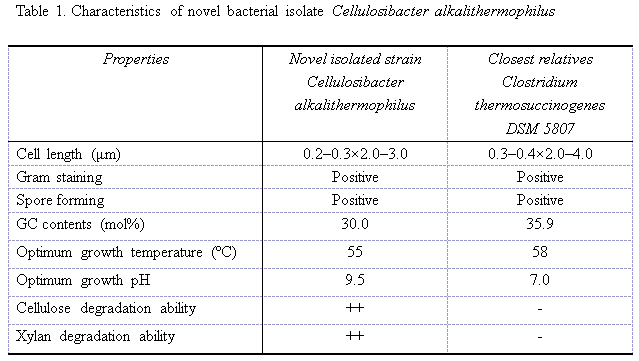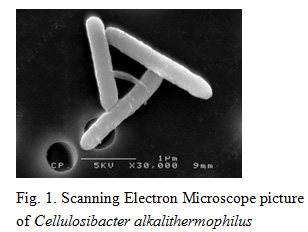Characterization of novel anaerobic alkalithermophilic, cellulolytic-xylanolytic bacteria
Description
Lignocellulosic plant biomass is difficult to hydrolyze because cellulose has a tightly packed crystalline structure and is surrounded by a lignin that has covalent associations with hemicellulose. Thus, the rate-limiting step in biomass degradation is the conversion of cellulose and hemicellulose polymers to sugars.
Pretreatment of lignocellulose can be enhanced to enzymatic digestibility. Alkaline pretreatment is one of several chemical pretreatment technologies that have been intensively investigated. It employs various alkaline reagents including sodium hydroxide, calcium hydroxide, potassium hydroxide, aqueous ammonia, ammonia hydroxide, and sodium hydroxide in combination with hydrogen peroxide. Mechanistically, alkali is believed to cleave hydrolysable linkages in lignin and glycosidic bonds of polysaccharides, which causes a reduction in the degree of polymerization and crystallinity, swelling of the fibers, as well as disruption of the lignin structure.
In general, alkaline pretreatment is more effective on hardwood, herbaceous crops, and agricultural residues, which have lower lignin content, than on substrates such as softwood, which contain high amounts of lignin.
The alkaline-treated lignocelluloses must adjust to neutral pH and/or remove completely alkaline reagents because cellulase and hemicellulases in subsequent saccharification process are unable to act under alkaline condition.To develop enzymes which have high degradation ability under alkaline condition, it is necessary to isolate alkalinephilic microorganisms having high cellulolytic ability.
We were able to successfully isolate an anaerobic alkalithermophilic, cellulolytic-xylanolytic bacterium from coconut garden soil in the Bangkuntien district of Bangkok, Thailand. The bacteria were Gram-stain positive, catalase-negative, endospore-forming, motile and rod-shaped, with a cell size of 0.2-0.3×2.0-3.0 µm. Optimal growth occurred at pH 9.5 and T=55 °C. The bacteria strain fermented various carbohydrates, and the end products from the fermentation of cellobiose were acetate, ethanol, propionate and a small amount of butyrate. Phylogenetic analysis based on 16S rRNA gene sequences revealed that the strain represented a new phyletic sublineage within the family Clostridiaceae, with <93.0% 16S rRNA gene sequence similarity to recognized species of this family. On the basis of phenotypic, genotypic and physiological evidence, the strain represents a novel species of a new genus, for which the name Cellulosibacter alkalithermophilus is proposed. C. alkalithermophilus showed high ability to degrade not only microcrystalline cellulose, but also hemicellulose such as xylan under alkaline condition at pH 9.5, suggesting that the bacteria might possess unique abilities to degrade polysaccharides .
The type strain of the type species has been deposited in the culture collection of Thailand Institute of Scientific and Technological Research as TISTR 1915(T)?.
Figure, table
- Affiliation
-
Japan International Research Center for Agricultural Sciences Biological Resources and Post-harvest Division
- Classification
-
Administration A
- Research project
- Program name
- Term of research
-
FY 2012 (FY 2011-FY2016)
- Responsible researcher
-
Kosugi Akihiko ( Biological Resources and Post-harvest Division )
Watthanalamloet A. ( King Mongkut's Institute of Technology Ladkrabang )
Tachaapaikoon Chakrit ( King Mongkut's Institute of Technology Ladkrabang )
ORCID ID0000-0001-9795-2558Ratanakhanokchai Khanok ( King Mongkut's Institute of Technology Ladkrabang )
- ほか
- Publication, etc.
-
A.Watthanalamloet et-al., International Journal of Systematic and Evolutionary Microbiology (IJSEM) (2012), 62, 2330-2335 http://ijs.sgmjournals.org/content/62/Pt_10/2330.long
- Japanese PDF
-
2012_20_A4_ja.pdf177.71 KB
- English PDF
-
2012_20_A4_en.pdf219.81 KB


